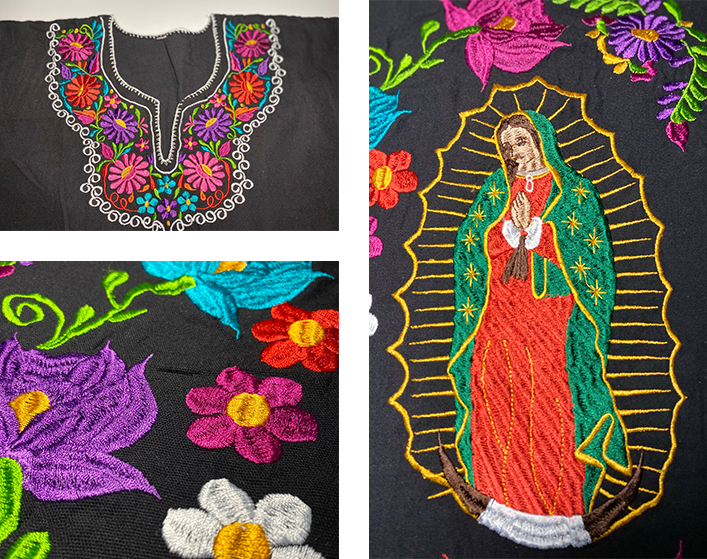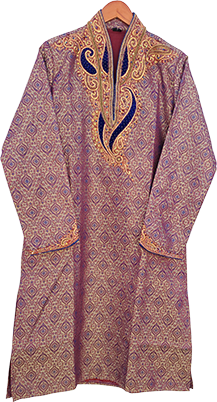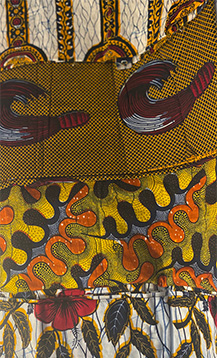Huipil
ABOUT
The Huipil dress contributed by Jennifer Gonzalez highlights embroidered design in colors on black. The flowers represent the life and joy of Mexican culture. The design of the Virgin of Guadalupe represents religious culture and as a national and representative symbol of Mexico.
The word Huipil comes from the Nahuatl dialect and means blouse, ornate dress or my covering. The use of this outfit is considered a tradition among indigenous women. Its origin dates from the pre-Hispanic era but it is still in use in Mexico and Central America. Its origin is Mayan of the Yucatan peninsula. The huipil began to be used as a blouse to be able to hide the parts of the body that women exposed before the era of colonization, when the Spaniards arrived in Mexico the women felt the shame of showing themselves naked in front of them, began to use this type of outfit. Initially these blouses were made of cotton and wool and sometimes pieces of silk to include their designs. The pattern used in this technique is embroidered in colors on a black fabric to make the color of the design stand out.
This type of Huipil represents the religious culture that is an important part of the identity of Mexicans. December 12, the day of the Virgin of Guadalupe, is one of the largest national holidays in Mexico, honoring the appearance of the Virgin to San Juan Diego, an indigenous person to whom, according to myth, the Virgin appeared in the year 1531. This holiday sets a pattern in the idiosyncrasy of Mexican culture and that is why the Huipil with the design of the Virgin of Guadalupe is symbolic and representative. The Virgin of Guadalupe in Mexico is something like the Flag that represents each Country.
In this beautiful dress, we can appreciate not only the talent that exists in the hands of those who made it, but also the importance of religion in the identity of many Mexicans.
Personally, I found it interesting to know the history of where the Huipil comes from. In my work I had the opportunity to share with people from Mexico and Guatemala who wear these blouses during religious festivals, as a symbol that represents not only their faith but also their culture. When I recognized the huipil when I was assigned to talk about its description and history, I immediately identified myself, because I had already the opportunity to see the huipil in person and know where it came from, it made me interested and appreciate even more this typical Mexican outfit.
—Alvaro Chavarriaga
The song “LaGuadalupana” is traditional when celebrating Dia de la Guadalupe. It tells the story of her first encounter and is always sung afterplaying Las Mañanitas (which is a Birthday song). In the first video, it’s still the same song but in the Banda musical genre. When we celebrate this event in church, a band is hired to play this song, showing the rich music culture of Mexico. In the event of Dia de laGuadalupe, we honor two saints. The Virgin Mary herself and Juan Diego, the indigenous man who first encountered her presence. Aside from reserving Huipil for special occasions, the homage of dressing as Juan Diego is a form of paying tribute. —Jennifer Gonzeles

ORIGIN
Mexico
APPROXIMATE DATE
21st Century
MATERIALS
Embroidered dyed cotton dyes and natural fibers
COLLECTION OF
Alvaro Chavarriaga

Huipil

ABOUT
The Huipil dress contributed by Jennifer Gonzalez highlights embroidered design in colors on black. The flowers represent the life and joy of Mexican culture. The design of the Virgin of Guadalupe represents religious culture and as a national and representative symbol of Mexico.
The word Huipil comes from the Nahuatl dialect and means blouse, ornate dress or my covering. The use of this outfit is considered a tradition among indigenous women. Its origin dates from the pre-Hispanic era but it is still in use in Mexico and Central America. Its origin is Mayan of the Yucatan peninsula. The huipil began to be used as a blouse to be able to hide the parts of the body that women exposed before the era of colonization, when the Spaniards arrived in Mexico the women felt the shame of showing themselves naked in front of them, began to use this type of outfit. Initially these blouses were made of cotton and wool and sometimes pieces of silk to include their designs. The pattern used in this technique is embroidered in colors on a black fabric to make the color of the design stand out.
This type of Huipil represents the religious culture that is an important part of the identity of Mexicans. December 12, the day of the Virgin of Guadalupe, is one of the largest national holidays in Mexico, honoring the appearance of the Virgin to San Juan Diego, an indigenous person to whom, according to myth, the Virgin appeared in the year 1531. This holiday sets a pattern in the idiosyncrasy of Mexican culture and that is why the Huipil with the design of the Virgin of Guadalupe is symbolic and representative. The Virgin of Guadalupe in Mexico is something like the Flag that represents each Country.
In this beautiful dress, we can appreciate not only the talent that exists in the hands of those who made it, but also the importance of religion in the identity of many Mexicans.
Personally, I found it interesting to know the history of where the Huipil comes from. In my work I had the opportunity to share with people from Mexico and Guatemala who wear these blouses during religious festivals, as a symbol that represents not only their faith but also their culture. When I recognized the huipil when I was assigned to talk about its description and history, I immediately identified myself, because I had already the opportunity to see the huipil in person and know where it came from, it made me interested and appreciate even more this typical Mexican outfit.
—Alvaro Chavarriaga
ORIGIN
Mexico
APPROXIMATE DATE
21st Century
MATERIALS
Embroidered dyed cotton dyes and natural fibers
COLLECTION OF
Alvaro Chavarriaga

The song “LaGuadalupana” is traditional when celebrating Dia de la Guadalupe. It tells the story of her first encounter and is always sung afterplaying Las Mañanitas (which is a Birthday song). In the first video, it’s still the same song but in the Banda musical genre. When we celebrate this event in church, a band is hired to play this song, showing the rich music culture of Mexico. In the event of Dia de laGuadalupe, we honor two saints. The Virgin Mary herself and Juan Diego, the indigenous man who first encountered her presence. Aside from reserving Huipil for special occasions, the homage of dressing as Juan Diego is a form of paying tribute. —Jennifer Gonzeles
OTHER OBJECTS FROM THE EXHIBITION






